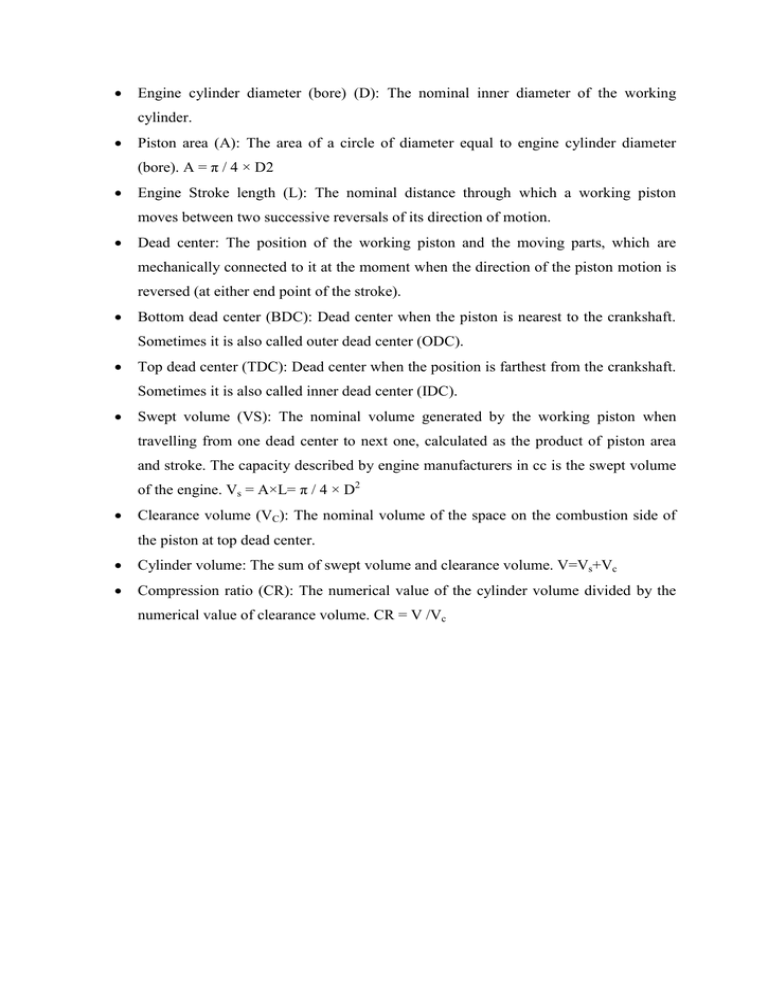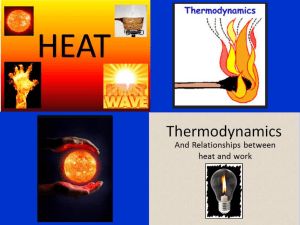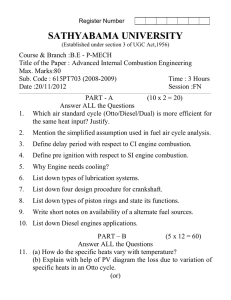• Engine cylinder diameter (bore) (D): The nominal inner diameter of
advertisement

Engine cylinder diameter (bore) (D): The nominal inner diameter of the working cylinder. Piston area (A): The area of a circle of diameter equal to engine cylinder diameter (bore). A = π / 4 × D2 Engine Stroke length (L): The nominal distance through which a working piston moves between two successive reversals of its direction of motion. Dead center: The position of the working piston and the moving parts, which are mechanically connected to it at the moment when the direction of the piston motion is reversed (at either end point of the stroke). Bottom dead center (BDC): Dead center when the piston is nearest to the crankshaft. Sometimes it is also called outer dead center (ODC). Top dead center (TDC): Dead center when the position is farthest from the crankshaft. Sometimes it is also called inner dead center (IDC). Swept volume (VS): The nominal volume generated by the working piston when travelling from one dead center to next one, calculated as the product of piston area and stroke. The capacity described by engine manufacturers in cc is the swept volume of the engine. Vs = A×L= π / 4 × D2 Clearance volume (VC): The nominal volume of the space on the combustion side of the piston at top dead center. Cylinder volume: The sum of swept volume and clearance volume. V=Vs+Vc Compression ratio (CR): The numerical value of the cylinder volume divided by the numerical value of clearance volume. CR = V /Vc Figure 3.13. Important positions and volumes in reciprocating engine In four-stroke cycle engine, the cycle of operation is completed in four strokes of the piston or two revolutions of the crankshaft. Each stroke consists of 1800 of crankshaft rotation and hence a cycle consists of 7200 of crankshaft rotation. The series of operation of an ideal four-stroke engine are as follows: Suction or Induction stroke: The inlet valve is open, and the piston travels down the cylinder, drawing in a charge of air. In the case of a spark ignition engine the fuel is usually pre-mixed with the air. Compression stroke: Both valves are closed, and the piston travels up the cylinder. As the piston approaches top dead centre (TDC), ignition occurs. In the case of compression ignition engines, the fuel is injected towards the end of compression stroke. Expansion or Power or Working stroke: Combustion propagates throughout the charge, raising the pressure and temperature, and forcing the piston down. At the end of the power stroke the exhaust valve opens, and the irreversible expansion of the exhaust gases is termed ‘blow-down’. Exhaust stroke: The exhaust valve remains open, and as the piston travels up the cylinder the remaining gases are expelled. At the end of the exhaust stroke, when the exhaust valve closes some exhaust gas residuals will be left; these will dilute the next charge. Performance parameters of internal combustion engines are as follows : Indicated thermal efficiency (ηt): Indicated thermal efficiency is the ratio of energy in the indicated power to the fuel energy. (ηt) = IndicatedPower /FuelEnergy ηt(%) = 𝐼𝑛𝑑𝑖𝑐𝑎𝑡𝑒𝑑𝑃𝑜𝑤𝑒𝑟(𝑘𝑊)×3600 𝐹𝑢𝑒𝑙𝐹𝑙𝑜𝑤( 𝐾𝑔 Kj )×CalorificValue( ) 𝐻𝑟 Kg × 100 Brake thermal efficiency (ηth): A measure of overall efficiency of the engine is given by the brake thermal efficiency. Brake thermal efficiency is the ratio of energy in the brake power to the fuel energy. Figure A shows the pressure (P) – volume (V) and temperature (T) – entropy (S) diagrams of idealized diesel cycle. Figure A. P-V and T-S diagrams of idealized diesel cycle Thermodynamically; 1 𝛼𝛾 −1 𝜂𝑡ℎ = 1 − 𝑟 𝛾−1 (𝛾(𝛼−1)) (ηth) = BrakePower/Fuel Energy ηth(%) = 𝐵𝑟𝑎𝑘𝑒𝑃𝑜𝑤𝑒𝑟(𝑘𝑊)×3600 𝐹𝑢𝑒𝑙𝐹𝑙𝑜𝑤( 𝐾𝑔 Kj )×CalorificValue( ) 𝐻𝑟 Kg × 100 Where; 𝜂𝑡ℎ is thermal efficiency, α is the cut-off ratio (ratio between the end and start volume for the combustion phase), cp is specific heat at constant pressure, cv is specific heat at constant volume, γ is ratio of specific heats (cp/cv), r is the compression ratio. Theoretical equation shows that thermal efficiency of the diesel cycle depends on three parameter which are; compression ratio (r), ratio of specific heats (γ) and cut-off ratio of the cycle (α). Mechanical efficiency (ηm): Mechanical efficiency is the ratio of brake horse power (delivered power) to the indicated horsepower (power provided to the piston). (ηm) = BrakePower/IndicatedPower FrictionalPower = IndicatedPower – BrakePower Volumetric efficiency (ηv): The engine output is limited by the maximum amount of air that can be taken in during the suction stroke, because only a certain amount of fuel can be burned effectively with a given quantity of air. Volumetric efficiency is an indication of the ‘breathing’ ability of the engine and is defined as the ratio of the air actually induced at ambient conditions to the swept volume of the engine. In practice the engine does not induce a complete cylinder full of air on each stroke, and it is convenient to define volumetric efficiency as: (ηv) = Actual air inducted/Theoretical air ηv(%) = AirFlow(Kg/Hr) Kg )×60 m3 π / 4 × D2L(m3)×N(rpm)/n×noc×AirDen( × 100 Where n= 1 for 2 stroke engine and n= 2 for 4 stroke engine. Specific fuel consumption (SFC): Brake specific fuel consumption and indicated specific fuel consumption, abbreviated BSFC and ISFC, are the fuel consumptions on the basis of Brake power and Indicated power respectively. Fuel-air (F/A) or air-fuel (A/F) ratio: The relative proportions of the fuel and air in the engine are very important from standpoint of combustion and efficiency of the engine. This is expressed either as the ratio of the mass of the fuel to that of the air or vice versa. Calorific value or Heating value or Heat of combustion: It is the energy released per unit quantity of the fuel, when the combustible is burned and the products of combustion are cooled back to the initial temperature of combustible mixture. The heating value so obtained is called the higher or gross calorific value of the fuel. The lower or net calorific value is the heat released when water in the products of combustion is not condensed and remains in the vapour form. Power and Mechanical efficiency: Power is defined as rate of doing work and equal to the product of force and linear velocity or the product of torque and angular velocity. Thus, the measurement of power involves the measurement of force (or torque) as well as speed. The power developed by an engine at the output shaft is called brake power and is given by Power = NT/60,000 in kW where T= torque in Nm = WR W = 9.81 * Net mass applied in kg. R= Radius in m N is speed in RPM Mean effective pressure and torque: Mean effective pressure is defined as a hypothetical pressure, which is thought to be acting on the piston throughout the power stroke. Power in kW = (Pm LAN/n 100)/60 in bar where Pm = mean effective pressure L = length of the stroke in m A = area of the piston in m2 N = Rotational speed of engine RPM n= number of revolutions required to complete one engine cycle n= 1 (for two stroke engine) n= 2 (for four stroke engine) Thus we can see that for a given engine the power output can be measured in terms of mean effective pressure. If the mean effective pressure is based on brake power it is called brake mean effective pressure (BMEP) and if based on indicated power it is called indicated mean effective pressure (IMEP). BMEP(bar) = IMEP(bar) = 𝐵𝑟𝑎𝑘𝑒𝑃𝑜𝑤𝑒𝑟(𝑘𝑊)×60 N n 𝐿×A×( )×noc×100 𝐼𝑛𝑑𝑖𝑐𝑎𝑡𝑒𝑑<𝑃𝑜𝑤𝑒𝑟(𝑘𝑊)×60 N n 𝐿×A×( )×noc×100 Thermodynamic Cycles Actual Cyle Otto Cycle Diesel Cycle Diesel const cV 1 1 rck 1 1 k 1 k r rc 1 Four Stages of Combustion in CI Engines





